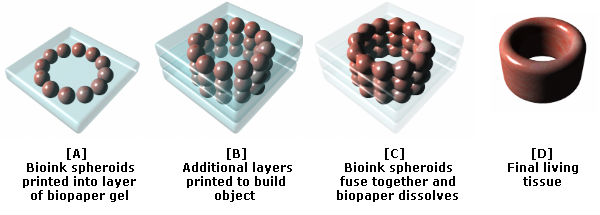Imagine being able to draw an organ in a CAD-style program and print it. While this exact scenario is still probably some years away, Organovo, the innovative San Diego-based medtech company founded in 2007, is on its way. Partnered with the product development firm Invetech, Organovo was the first to make the leap from two-dimensional bioprinting to the three-dimensional realm. Together, the collaboration has been involved in all aspects of research, development and logistics to bring 3D bioprinting to medical research facilities. Which begs the question…
…How Do You Build A Liver?
How to print a tissue. Source: ExplainingTheFuture.com
The key ingredients are human cells and a hydrogel, scaffold, or support matrix, the biological “glue” binding the cells together. The organ sculptor begins by drawing the liver in a user-friendly graphical interface. This bio-blueprint is then fed to the printer, which consists of two printheads, one to place the human cells, the other to position the support matrix. While designing the Novagen bioprinter, one of the key challenges encountered in the development phase was precision control. The solution? A laser calibration system to ensure that the cell dispenser deposits the cell at just the right micronic coordinate.
The team reached a milestone two years ago with the first successful creation of a human vein. Since then, they have been hard at work to reach the next, pivotal step: human organs. They have already succeeded in printing cardiac muscle and lung tissues. First, one begins by growing the cells in a culture. With the aid of an enzyme, the cells detach from the culture and incubate further in a pellet, where they slowly attach to one another, forming a multi-cell structure, or tissue.
The pellet then injects this mini-tissue unit into a nutrient-rich Petri dish culture were the cells continue to grow and attach, forming larger and larger tissue units, and the bio “ink” used in the printhead. A script then squirts the ink into the desired formation, one line at a time. Within a few days of settling, you have a tissue identical to that found in the human body.
The Future
What is the future of 3D bioprinting? Among more starry-eyed visions of entire organ farms, more near-future applications include improved drug testing for pharmaceautical companies. Using a near-identical chunk of human tissue produced at will enables us near limitless testing ground to try out new drugs. It can also be a more effective and ethical alternative to animal flesh or human test subjects. And the lessons learned in the initial drug testing phases could rule out bad drugs and save companies billions of dollars on dead-end schemes.
With the already expensive, mounting medical costs plaguing our society today, companies like Organovo offer hope for the future.







